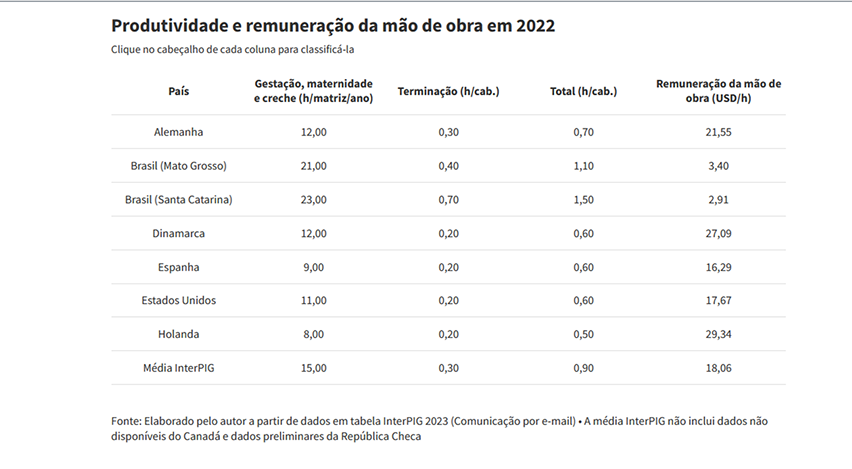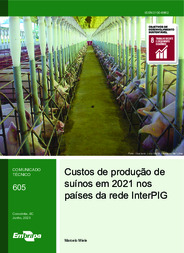Brazil has lowest pig production cost among 17 countries
Brazil has lowest pig production cost among 17 countries
|
Brazil remains a world leader among 17 countries in the cost of pig production in U.S. dollars per kilo of live weight. The country's estimates are based on data from the states of Mato Grosso (MT) and Santa Catarina (SC). In 2022, the production cost per kilo of live weight was US$1.13 in Mato Grosso and US$1.28 in Santa Catarina . Although costs rose respectively 10% and 12% in those states in comparison with 2021, the figures are still lower than in the United States (US$ 1.42/kg lw), Denmark (US$ 1.49), Spain (US$ 1.66), the Netherlands (US$ 1.74) and Germany (US$ 1.83). The average for the countries that are part of the InterPig network is US$ 1.72/kg liveweight (more details in the charts below).
Global swine production costs increased significantly in 2022 The data were compiled by the Group for the Comparison of Production Costs in Pig Farming (InterPig network), which gathers institutions from 17 pork-producing countries, including Brazil as represented by Embrapa Swine and Poultry. The figures were presented this year during the group's meeting.
Moreover, the lowest prices received per kilo of live weight are also found in Brazil, with US$ 1.06 in Mato Grosso and US$ 1.10 in Santa Catarina, in contrast with the average in the United States, for instance, where it is US$ 1.58\kg lw. Such figures, as well as the performance of Brazilian production in sow productivity, slaughter weight, weight gain at termination and feed conversion can be seen in charts produced by Embrapa (below).
“The main goal of publicizing the information is to bring it to inform stakeholders in the production chain in Brazil about the level of competitiveness of their main competitors,” reports Marcelo Miele, researcher in socio-economics at Embrapa Swine and Poultry, in Santa Catarina. He stated that all countries showed a significant increase in production costs in 2022 and that the prices received for pigs also increased; however, in most countries the variation was lower than the costs and generated losses in pig farming, with the expection of the United States.
The researcher explains that the general increase in production costs in 2022 occurred mostly due to the prices of corn and soybean meal. Animal feed inputs were impacted both by climate and geopolitical events such as the war in Ukraine, which made fertilisers more expensive and reduced the global grain supply. Miele adds: “In addition, global inflation in prices (electricity, drugs and vaccines, and construction), labour and its impact on interest rates also contributed.”
Expanding exports
The general scenario in 2023 was a drop in feed prices and of stability in other prices at high levels, except for a mild relief in electricity and an increase in wages. The prices received per kilo of live swine also show a trend to recover in most countries. Therefore, the researcher points to the prospect of expanded opportunities for Brazilian exports next year.
“Today [those exports] take fourth place in the international market for pork, but they could take third place if shipments from Brazil surpass those from Canada. If this is reflected in the prices received by farmers, there will be a positive impact on profit margins,” Miele observes.
The main factors that explain lower costs in Brazil than those other countries relate to production efficiency and pricing. On the one hand, the country has presented competitive animal farming indicators, which is a result of incorporating technology and herd health practices through investments in farm biosafety and agricultural defense.
The lower wages for labour and the lower cost of installations are also noteworthy. As for wages, Brazil has much lower levels than those practiced abroad; the hourly rate in 2022 was around US$ 3, while in an important competitor like Spain, it is US$16.29 (see table below).

However, the cost of animal feed was the main determinant. Pig farming in Mato Grosso had the lowest feed cost in the comparison. In that state, an average of US$ 0.87 was spent to produce one kg of live pigs, given the low feed conversion and lower feed prices.
In Santa Catarina, this amount was around US$ 1.02 and was determined by low feed conversion, considering higher feed prices. In contrast, Denmark and the United States had a cost of US$ 0.96 and US$ 1.03 per kg of live animal, respectively (learn details in the chart below).
The tables with the main results and the three charts are available at Embrapa's Swine and Poultry Intelligence Center (CIAS) , under “custos de suínos”/swine costs. Global costs since 2010 can be consulted on CIAS' website. A more detailed analysis of the results will be available by the end of the year in a Technical Communiqué.
InterPIGInterPig involves institutions from 14 European countries (Germany, Austria, Belgium, Denmark, Spain, Finland, France, Netherlands, Hungary, Ireland, Italy, United Kingdom, Czech Republic, and Sweden), 2 North-American countries (Canada and the United States), and Brazil, with estimates for Mato Grosso, in the country’s Midwest, and Santa Catarina, in the South. The data presented for 2022 do not include the estimates for Canada, as they are not yet available, and for the Czech Republic, which are still preliminary.. The InterPIG meeting occurs annually, and it involves the main research institutions that study the competitiveness of pig farming in the main producing countries. Since 2008, Embrapa Swine and Poultry has contributed with estimates for Santa Catarina, where it relies on the partnership with a cooperative union and prices collected by the Center for Socioeconomics and Agricultural Planning (Epagri/Cepa), and for Mato Grosso, counting on the partnership with the Mato Grosso Institute of Agricultural Economics (IMEA) and the Association of Swine Breeders of Mato Grosso (Acrismat). For both states, Embrapa uses performance statistics on the sows available in the Best of Pig Farming (Agriness) contest. |
Lucas Scherer Cardoso (MTb 10.158/RS)
Embrapa Swine and Poultry
Press inquiries
suinos-e-aves.imprensa@embrapa.br
Phone number: +55 49 3441-0400
Translation: Mariana Medeiros (13044/DF)
Superintendency of Communications
Further information on the topic
Citizen Attention Service (SAC)
www.embrapa.br/contact-us/sac/





